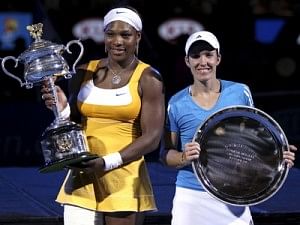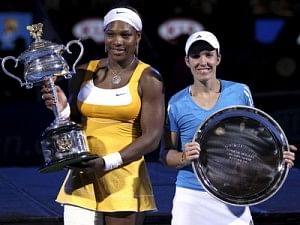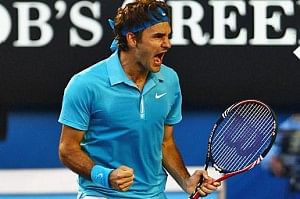
Roger Federer and Serena Williams: The Immortalization Of A Champion
There may not be a lot of aesthetic elements to Serena Williams’s game, but it wouldn’t be hard to find an enthusiastic poet willing to wax eloquent about her serve and perhaps even immortalize it in verse. Man, that serve. The utter, devastating control that she commands over such a complex action would have to go down as the defining image of the Williams’ power era. Watching her serve is somewhat like watching a slow motion capture of a missile taking off. There’s a lull as she takes the ball in her hand, her head as still as a rock and eyes locked straight ahead in an intense focus. She then proceeds to engage in the ball-bouncing routine that has many different versions patented by modern tennis players; the Serena version consists of bouncing the ball a LOT of times – the more pressure-filled the situation, the greater the number of bounces. And then, just as you start to think that the stories of Serena’s deficient fitness that constantly swirl around tennis circles are probably true and that she’s probably sapped out of her energy and is now just trying to buy time to avoid making a nervous mess of her delivery, she steps up to the service line, throws the ball in the air for a perfect toss (take note, Ana Ivanovic), and in one fluid, elegant motion sends down a thunderbolt that blazes past her resigned opponent for an ace or service winner. It’s a sight like no other in modern tennis – sound technique, perfect mechanics and awe-inspiring power. I’m no tennis coach, but I believe instructors around the world would do well to use the Serena serve as a quick, all-in-one guide to serving; all they’ve got to do is play a video of Serena delivering a particularly efficient serve and go, “And that, kids, is how it’s done”.
Serena Williams’s serve may not be the only reason why she’s won 12 Grand Slams, but it is the most important one. Her ability to be mind-numbingly consistent with her most valuable weapon in the crunch moments of a match to the extent that she can rely on it as though her life depended on it must be a source of great dejection for her opponents. As she and Justine Henin put on one of the most riveting women’s Slam finals in recent memory, the one shot that seemed destined to separate the winner from the loser was Serena’s serve. Henin, playing in only the second tournament of her much-celebrated comeback, matched, and occasionally even surpassed, Serena in shot-making and speed around the court.

Serena Williams and Justine Henin at the trophy presentation
Henin’s tactical strategy during the match may be questioned by some, as she kept sending ball after ball flying beyond the baseline in her bid to adopt the super-aggressive style that she believes will net her a Wimbledon trophy come July, but her heart and tennis skill cannot be doubted by even the harshest of skeptics. Ultimately, it all came down to whether Serena’s inner gladiator would make an appearance; and as expected, when push came to shove, she decided to bring the heat, and wipe out all thoughts of defeat from her mind and her tennis. Just as she had in her astonishing comeback victory against Victoria Azarenka in the quarterfinals. Just as she has throughout her career, ambushing scores of opponents with her unique mix of grit, power and relentlessness. Henin certainly is a hugely welcome addition to women’s tennis, as was Kim Clijsters last year, because if there’s one thing the WTA greatly needs these days, it is quality competition at the top. But if anyone doubted it before, Serena proved once again that when she’s on her game, no amount of fanfare or elegant tennis can snatch away the prize that she’s got her eye on.
At the other hand of the spectrum, Roger Federer continued to solidify his hold over the record books, clinching yet another Grand Slam title, bringing his ever-expanding record total to 16. Yes, I know I’m sounding like a broken record. No, I will not deny that I had to stifle a yawn as I typed that. Is there anything more that Federer can do in his career that can surprise us? There were theories that accomplishing the career Grand Slam, breaking Pete Sampras’s record of 14 Major titles and becoming a father of twin girls, in that order, would have caused Federer’s motivation and desire to wane. Well, those ‘theories’ have well and truly quickly been consigned to the rubbish bin, much to the embarrassment of all the doubters (which include, I’m almost ashamed to admit, yours truly). The question “where does he go from here?” has long gone past the stage of inappropriateness – it has become irrelevant now.

Roger Federer roars in delight during his title run at the Australian Open
The scary thing for his opponents, of course, is that not only is the man showing no signs of slowing down, he’s actually improving in some areas. His backhand was on fire for pretty much the entire tournament, reducing Andy Murray’s well-tested ploy of constantly attacking Federer’s supposedly weaker wing to laughably ill-conceived futility. The serve, which was sorely missing in last year’s final against Rafael Nadal, was clicking beautifully, and his movement was back to that unique set of bodily motions that people have been known to describe, at different times, as balletic, magical or ethereal. It was hardly a wonder that barely half an hour into the match Murray’s confident swagger from his earlier matches in the tournament (particularly his quarterfinal against Nadal, a match in which he played some stunningly offensive tennis) was completely gone, and he was cowed into reverting back to his ultra-defensive, counterpunching style. It’s like a vicious cycle, playing against Federer in a Slam final: his brilliant shot-making off the blocks gets his opponent all defensive and tentative, which in turn gives Federer confidence in his strokes, which in turns leads to more brilliant shot-making, which in turn leads to frustration and wild errors and general despondence on the other side of the net, and so on and so forth. I can’t imagine that being in such a situation can be a cheerful prospect for anyone (unless, of course, your name is Rafael Nadal). It’s not surprising that Federer scores so many of his wins before even stepping on the court – his reputation is usually enough to do the trick.
People have literally run out of superlatives to heap on Federer and the never-ending magnificence of his career. He’s turned into a sportswriter’s nightmare: there are, after all, only so many new angles you can write about when the same thing is repeated over and over again. Is this the definitive sign that the man has reached the pinnacle of his powers, the absolute dizzying peak that will forever be immortalized in his legacy? Wait – weren’t we saying that very same thing back in 2006?
The article was published in the third Sportskeeda E magazine